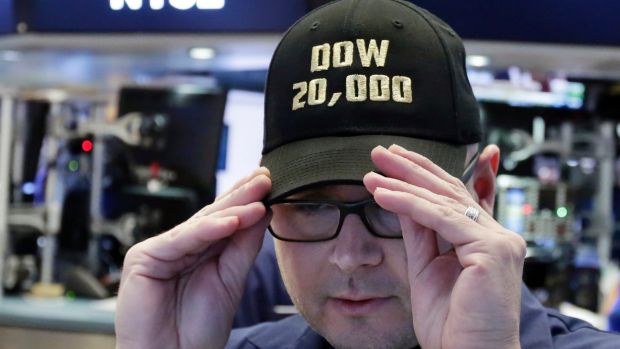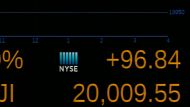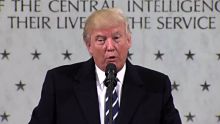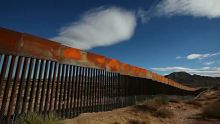Yes, it is just another number.
But in an industry that lives and dies by the power (seen and unseen) of sums in all their varieties, that the Dow Jones industrial average closed above 20,000 on Wednesday was enough to give even the most hardened stock market watchers reason to smile. The Dow finished the day at 20,068.51.
More World News Videos
Dow takes first-ever leap above 20,000
The Dow surged above the 20,000 mark for the first time in history as a solid earnings season and optimism over possible Trump policies fueled investor optimism.
"It blows me away," said Jim Paulsen, chief market strategist at Wells Fargo Asset Management. "I can remember when people wondered if we would ever get through Dow 1000. It's amazing we are up 20-fold in my career."
And that is a big deal, Paulsen explained, because it means that for all the worry and doubts that have sprung from the market collapses in 1987, 2000 and 2008, if investors just held to a core portfolio of large American stocks they would have done pretty well.
Of course, the usual caveats apply.
In percentage terms, the Dow going from 10,000 (which it hit in March 1999) to 20,000 is less meaningful than the journey from 1000, which it reached in 1972.
It is also true that the Dow represents just 30 companies including stalwarts like Goldman Sachs, Apple and Wal-Mart compared with the 500 that make up the Standard & Poor's index or the 2000 of the Russell market tracker.
And in today's ETF-driven marketplace, where indexes of every stripe are used to entice investors looking for cheap and predictable returns, the Dow as an index for exchange-traded funds has been more or less ignored, compared to funds that follow the S&P; 500 and Russell 2000.

After all, from the perspective of financial adviser seeking maximum diversification for his client, an ETF that tracks just 30 stocks is not as compelling to the alternatives that represent a broader swath of the US economy.
'One of the more reliable indicators'
The ETFs that follow the S&P; 500 and the Russell 2000 turn over 92 million and 32 million shares, respectively.
Still, even if the power of 20,000 is more psychological than quantifiable, that should not necessarily weaken its punch, especially today when there are so many different forms of media that can advertise the accomplishment.
"I think it is meaningful," said Ed Yardeni, an independent and long-standing market strategist. "No matter what your politics are or what fears you may have this index is one of the more reliable indicators we have in terms of where the economy is heading."
As did Paulsen, Yardeni underscores the durability factor in describing why 20,000 should be recognised.
His team of analysts tracks what he calls panic attacks, or headline-driven falls in the market that could last months or days. There have been 55 of these selling fits since the start of this bull market in early 2009, every one of which has been followed by a relief rally.
It is this very point, however, that worries some market seers.
"It has taken over 17 years to get here," said David Kelly, head of global strategy at JP Morgan Asset Management. "We hit 10,000 on a wave of enthusiasm but we have had to climb a wall of worry all the way up to 20,000."
Great! #Dow20K https://t.co/wXFhXBLgag
— President Trump (@POTUS) January 25, 2017
Kelly makes some cautionary points in terms of urging investors not to get carried away with the number.
The recent post-election surge toward 20,000 has been driven by what investors are calling a reflation trade, or a bet that the economy under President Donald Trump will benefit from proposed tax cuts and a move toward more aggressive government spending.
'The greatest sucker's rally in history'
Earlier Wednesday, responding to an Associated Press report on Twitter that the index had traded above 20,000 for the first time, Trump sent a tweet from the president's official Twitter account that said, "Great!"
People should also be aware, Kelly said, that expected cuts in capital gains taxes has kept many investors from taking profits during the rally. The thought being, that if they were to wait several months, they could dump their stocks and face a lighter tax bill in the process.
"The exit door is jammed," he said.
Kelly also warns that this rally has been unusually focused on the United States. This will be the fourth consecutive year that domestic stocks have outperformed their counterparts in overseas markets developed and emerging.
Such a streak is rare indeed, and it highlights the extent to which the dollar's strong run of late has bolstered the market's performance.
To Kelly's point, some economists have begun to point out that a dollar that consistently outpaces all other world currencies should be seen as a warning signal. That is because companies and countries that have borrowed a lot in dollars will have trouble repaying those debts as their own currencies weaken.
Then there are the "perma-bears" who see Dow 20,000 as just the latest sign that the end is nigh.
"The number is meaningless, this is the greatest sucker's rally in history," said David A. Stockman, the former budget chief for President Ronald Reagan who gained renown for publicly rejecting the notion of Reaganomics in the early 1980s. "The Dow has no business being anywhere close to these levels."
Stockman disputes the notion, embraced today by stock market bulls, that Trump can cut taxes and increase government spending while leaving Medicare and Social Security alone without creating a debt and deficit crisis.
And he is putting his money where his mouth is. Since the election, he has made bets that the market will fall sharply from these levels.
"This is the greatest short of all time," Stockman said.














